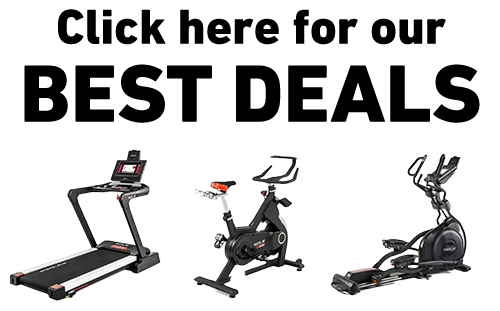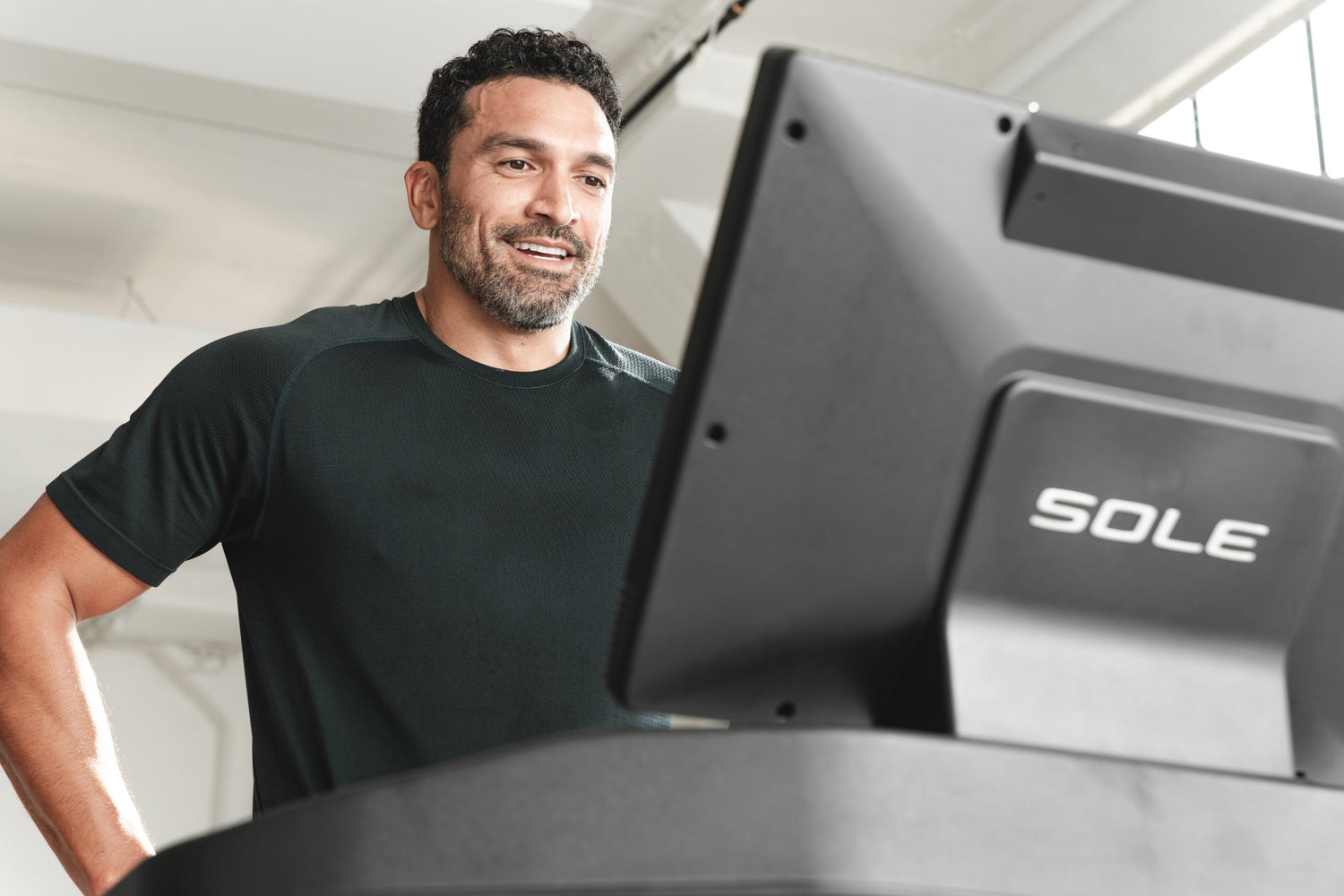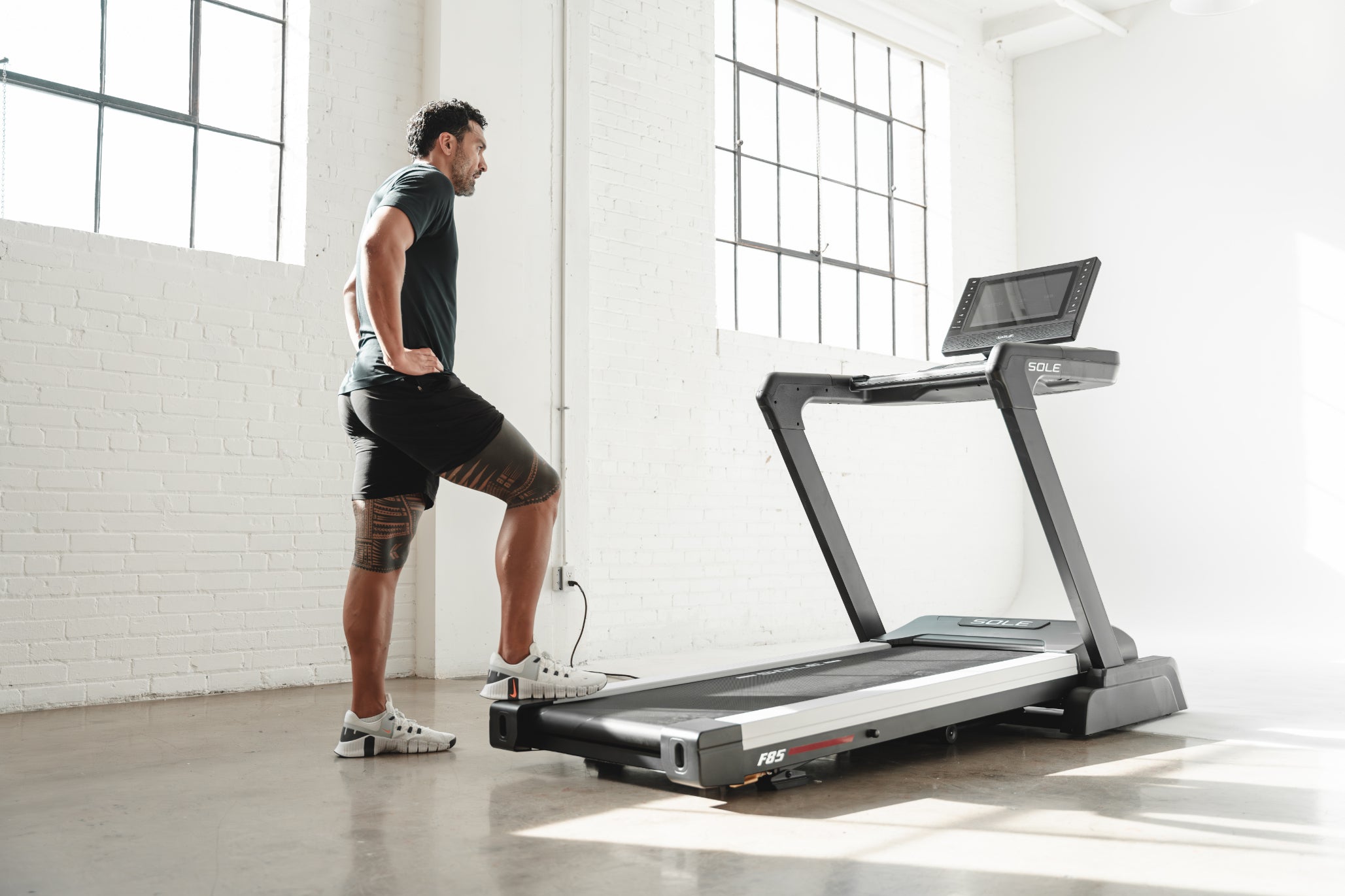Key Takeaways
- Walking on a treadmill can significantly improve heart health by enhancing heart function and reducing the risk of heart disease.
- Regular treadmill walking helps regulate blood pressure, making blood vessels more flexible and reducing stress on the heart.
- It increases muscle strength, particularly in the legs and core, and contributes to overall body tone.
- Walking on a treadmill supports weight loss by burning calories, reducing fat, and boosting metabolism.
- This exercise promotes bone health, increases bone density, and helps prevent osteoporosis.
|
At SOLE Fitness, we're proud to offer the best treadmills for your home or gym. These machines are crafted to meet the highest standards of quality and performance, so they are ideal for anyone - from fitness novices to seasoned athletes. Featured Product
|
When you step onto a treadmill and start walking, your body begins to experience immediate physical benefits. These benefits go beyond just the calories burned - they extend to your cardiovascular system, muscles, bones, and even your mental health.
May Strengthen Heart Health
Improvement in Heart Function
Walking on a treadmill is a form of aerobic exercise, which means it gets your heart pumping and your blood flowing. This type of exercise is crucial for improving heart function. A 2013 study found that a 2 to 7 percent incline increased heart rate by almost 10% compared to walking on a flat surface.
Lower Risk of Heart Disease
Regular treadmill walking makes the heart pump more efficiently - thus, reducing the risk of heart disease. This is because treadmill walking helps reduce cholesterol levels, manage blood pressure, and maintain a healthy weight - all factors that contribute to heart health.
Enhanced Blood Circulation
Besides improving heart function, treadmill walking also enhances blood circulation. When you walk, your muscles contract and relax, helping to push blood back to the heart. This improved circulation means that your organs and tissues receive the oxygen and nutrients they need to function optimally.
Regulates Blood Pressure
Stabilizes Hypertension
High blood pressure, or hypertension, is a common health issue that can lead to serious complications if left unmanaged. Walking on a treadmill can help stabilize blood pressure.
A study published in the Journal of Strength and Conditioning Training found that both treadmill running and resistance exercises can help lower blood pressure in hypertensive individuals during daily activities. In fact, the treadmill group saw greater reductions in systolic and diastolic blood pressure compared to the resistance exercise group.
The American Heart Association states that increasing physical activity can lower blood pressure by 3-4 mmHg and LDL cholesterol by 3-6 mg/dL. Physically active people also have a 21% lower risk of cardiovascular disease and a 36% lower risk of death from it compared to inactive individuals. So, why not incorporate treadmill walking today?
Improves Blood Vessel Flexibility
Regular treadmill walking also improves the flexibility of your blood vessels. Flexible blood vessels can expand and contract more easily, which helps to regulate blood pressure and reduce the risk of hypertension-related complications.
Reduces Stress on the Heart
By stabilizing blood pressure and improving blood vessel flexibility, treadmill walking reduces the overall stress on your heart. This means your heart doesn't have to work as hard to pump blood throughout your body, leading to better cardiovascular health and reduced risk of heart-related issues.
Increase in Muscle Strength
Building Leg Muscles
Walking on a treadmill primarily targets the muscles in your legs, including the quadriceps, hamstrings, calves, and glutes. Over time, regular treadmill walking can lead to significant improvements in leg muscle strength and endurance.
In fact, a study found that a treadmill walking program improved muscle strength and balance in elderly people with Down syndrome. The program included 30 minutes of treadmill walking 3 times per week for 12 weeks.
Core Strengthening
While it may not be as obvious, treadmill walking also engages your core muscles that stabilize the spine, pelvis, and trunk. Maintaining good posture while walking helps strengthen the muscles in your abdomen and lower back, contributing to better overall stability and balance.
A study on stroke patients investigated the effects of lower extremity muscle strengthening exercise on gait and balance. The treadmill walking group showed improved walking ability and balancing ability compared to the control group.
Impact on Overall Body Tone
Consistent treadmill walking can lead to a more toned and defined body. As you build muscle and burn fat, you'll notice improvements in your overall body composition. This can enhance your physical appearance and boost your confidence.

Supports Weight Loss
Calorie Burn
One of the most straightforward ways treadmill walking helps with weight loss is through calorie burn. Depending on your weight and treadmill’s speed and incline settings, you can burn between 100 to 300 calories in 30 minutes.
This calorie deficit, when combined with a healthy diet, can lead to significant weight loss over time. To burn calories even faster, run longer and faster on the machine - HIIT treadmill workouts can burn calories at a faster rate than other aerobic exercises.
Fat Reduction
Besides burning calories, treadmill walking specifically targets fat stores. According to a study published in the Turkish Journal of Physical Medicine and Rehabilitation, treadmill walking can reduce visceral fat thickness (VFT) - the dangerous fat that surrounds your organs.
Boosts Metabolism
Walking on a treadmill can also boost your metabolism. When you walk, your body requires more energy and you build stronger muscles. All this can increase your metabolic rate - which means you continue to burn calories even after you've finished your workout.
Promotes Bone Health
Increases Bone Density
Walking on a treadmill can have a positive impact on your bone health. This is particularly important as we age, as bone density tends to decrease, increasing the risk of fractures and osteoporosis.
Fortunately, weight-bearing exercises like treadmill walking are known to increase bone density. According to a study published in the Journal of the Medical Association of Thailand, moderate intensity treadmill walking exercise for 30 minutes, 3 times a week can reduce bone resorption and bone turnover markers in menstruating and menopausal women. All this will lead to better bone density and lower risk of osteoporosis.
Supports Joint Health
In addition to benefiting your bones, treadmill walking may support joint health. Walking helps lubricate the joints, reducing stiffness and pain. This is especially beneficial for individuals with arthritis or other joint-related conditions.

Enhances Digestion
Prevents Constipation
Some studies suggest that regular walking exercise, including on a treadmill, can improve constipation and associated symptoms like bloating. This is because walking stimulates the muscles in the intestines, helping to move stool through the digestive tract. While more research is needed, incorporating treadmill walking into a daily routine may have benefits for digestive health.
Supports Efficient Nutrient Absorption
Efficient digestion means that your body can absorb nutrients more effectively. This is crucial for overall health, as it guarantees that your body gets the vitamins and minerals it needs to function properly. Regular treadmill walking can help maintain a healthy digestive system, supporting efficient nutrient absorption.
Improved Glycemic Response
Research also shows that brisk walking for 30 minutes after a meal can improve glycemic response, even with varying carbohydrate amounts in the meal. Breaking up bouts of sitting with light-intensity walks can help reduce postprandial glucose and insulin levels.
So, this does not only manage blood sugar levels but also helps to protect the heart even more since uncontrolled blood sugar level is one of the risk factors of heart diseases.
Improves Sleep Quality
Promotes Deeper Sleep
Regular physical activity, such as treadmill walking, can help you fall asleep faster and enjoy deeper, more restorative sleep.
A 2022 study examined the relationship between walking activity and sleep quality among 1,211 community-dwelling older adults. They found that walking more than once per day and walking for longer durations were associated with better sleep quality.
Similarly, a 2021 research found that treadmill walking can improve sleep quality by reducing sleep latency and increasing slow-wave sleep (SWS) - also known as deep sleep, this is the period where the body enters into deep and restorative rest.
Regulates Sleep Patterns
Walking on a treadmill can also help regulate your sleep patterns - exercise helps to set your internal clock, making it easier to fall asleep and wake up at consistent times. This can be particularly beneficial for individuals who struggle with irregular sleep schedules.
According to the Sleep Foundation, individuals who engage in moderate to vigorous exercise have a shorter sleep onset (AKA the time it takes to fall asleep). It also reduces daytime sleepiness and the need to take sleeping medications.
Reduces Insomnia Symptoms
Insomnia is a common sleep disorder that can significantly impact your quality of life. Regular treadmill walking has been shown to reduce the symptoms of insomnia, helping individuals fall asleep faster and stay asleep longer.
For example, a 2014 study looked at the effects of a 16-week exercise program on sleep quality in older adults with insomnia. The exercise group showed significant improvements in sleep quality, mood, and quality of life compared to the control group.
Boosts Mental Health
Reduces Anxiety
Exercise is a natural stress reliever, and walking on a treadmill is no exception. Regular physical activity can help reduce anxiety by promoting the release of endorphins, which are chemicals in the brain that act as natural painkillers and mood elevators. According to the Anxiety and Depression Association of America, regular exercise can significantly reduce anxiety symptoms.
Alleviates Depression
Besides reducing anxiety, treadmill walking can also alleviate symptoms of depression. Physical activity increases the production of neurotransmitters like serotonin and dopamine, which are crucial for regulating mood. A 2021 randomized controlled trial found that treadmill walking at moderate intensity (40-60% of max heart rate) 3 times per week improved anxiety, depression, and social well-being in women with type 2 diabetes.
Enhances Mood and Happiness
Regular treadmill walking can enhance your overall mood and increase feelings of happiness. This is due to the release of endorphins and the reduction of stress hormones like cortisol. Walking also provides a sense of accomplishment, which can boost self-esteem and overall well-being.
Enhances Cognitive Power
Improves Memory
Regular treadmill walking can improve your memory and cognitive function. According to the National Institute of Aging, exercise boosts the production of FNDC5. It’s a protein that can activate the neuroprotective genes in the hippocampus - the brain region responsible for memory formation.
Boosts Motor Skills
Walking on a treadmill can also boost your motor skills. A pilot study found significant improvements in cognitive and motor performance in patients with mild to moderate Parkinson’s disease after four weeks of treadmill training without bodyweight support. This can be particularly beneficial for elderly people.
Start Walking on Your SOLE Treadmills
Walking on a treadmill offers a myriad of benefits for both your body and mind. From improving heart health and regulating blood pressure to boosting mental health and enhancing cognitive power, this simple exercise can have a profound impact on your overall well-being.
Staying healthy becomes easier when you incorporate regular treadmill walking into your fitness routine, allowing you to enjoy these benefits and improve your quality of life. Lace up your sneakers, hop on your SOLE or any other treadmill, and start walking your way to better health today! And if you're in the market for a reliable treadmill, be sure to check out the quality options from SOLE treadmills.
By incorporating regular treadmill walking into your fitness routine, you can enjoy these benefits and improve your quality of life. Lace up your sneakers, hop on your SOLE or any other treadmill, and start walking your way to better health today! And if you're in the market for a reliable treadmill, be sure to check out the quality options from SOLE treadmills.
Frequently Asked Questions
Is treadmill walking suitable for all ages?
Yes, treadmill walking is suitable for individuals of all ages. It is a low-impact exercise that can be easily adjusted to suit different fitness levels and abilities. However, it's always a good idea to consult with a healthcare provider before starting any new exercise routine, especially for older adults or those with pre-existing health conditions.
How long should I walk on a treadmill daily?
The recommended duration for treadmill walking can vary based on individual fitness goals and levels. However, a general guideline is to aim for at least 30 minutes of moderate-intensity walking, five days of the week. This can be broken down into shorter sessions if needed.
Adults need at least 150 minutes of moderate-intensity physical activity a week, such as 30 minutes a day, 5 days a week. Adults also need 2 days of muscle-strengthening activity each week. — Centers for Disease Control and Prevention (CDC)
Are there any common mistakes to avoid on a treadmill?
Yes, there are a few common mistakes to avoid when walking on a treadmill:
- Not warming up properly before starting
- Holding onto the handrails too tightly
- Overstriding or taking steps that are too long
- Not maintaining good posture
- Ignoring the incline feature
Does treadmill walking help with posture?
Yes, treadmill walking can help improve your posture. Walking with proper form and maintaining an upright posture engages your core muscles and helps strengthen your back and abdominal muscles. This can lead to better overall posture and reduce the risk of back pain and other posture-related issues.
What is the best time of day to walk on a treadmill?
The best time to walk on a treadmill is whenever it fits best into your routine and allows you to stay consistent with your exercise. Some people prefer walking in the morning to start their day with a burst of energy, while others find it more convenient to walk in the evening to unwind after a long day.




Leave a comment
This site is protected by hCaptcha and the hCaptcha Privacy Policy and Terms of Service apply.